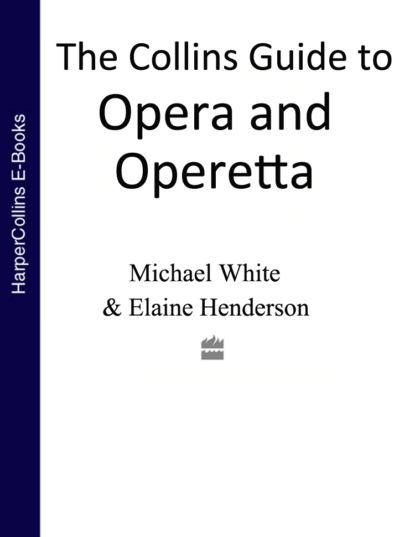По всем вопросам обращайтесь на: info@litportal.ru
(©) 2003-2024.
✖
The Collins Guide To Opera And Operetta
Автор
Год написания книги
2018
Настройки чтения
Размер шрифта
Высота строк
Поля
Tenor
Claudio, an officer
Baritone
Somarone, an orchestral conductor
Bass-baritone
Synopsis of the Plot
Setting: Messina, Italy; around 1700
ACT I The townspeople gather to celebrate Don Pedro’s defeat of the Moors. Héro is joyfully anticipating the return of her beloved, Claudio, but her cousin, Béatrice, is not so happy to contemplate the return of Bénédict, with whom she has a much more volatile relationship, one in which neither is willing to admit their true feelings for each other. The victorious forces soon arrive and Héro and Claudio happily arrange their wedding for that very evening. They encourage Bénédict to do the same, but he scoffs at the idea of marriage and declares that, if he is ever foolish enough to do such a thing, they can hang a banner on his roof announcing ‘Here is Bénédict, the married man’. This prompts Don Pedro and Claudio to hatch a plot to achieve just that. Later, Bénédict, hiding behind a hedge, hears an arranged conversation in which Béatrice confesses that she is very much in love with him – and Béatrice subsequently hears Bénédict say the same about his feelings for her. Their ideas on marriage now begin to change.
ACT II The wedding feast is well underway and, offstage, Somarone is encouraged to perform a noisy drinking song. In a quiet moment Béatrice again admits her true feelings for Bénédict and even welcomes the emotions she had for so long denied. But old habits die hard and when Bénédict appears she cannot resist baiting him in the usual way, although it is clear that a new tenderness underlies their ripostes. Claudio and Héro sign the marriage contract. The scribe has, by chance, another contract to hand and asks if anyone else wants to make use of it. Béatrice and Bénédict agree to take each other – out of pity, of course – and the banner is duly produced!
Music and Background
Berlioz’s last major work, Béatrice et Bénédict is nonetheless a short opera (one and a half hours), lightly written – ‘with the point of a needle’, as its composer said. It has brief scenes of spoken dialogue which link the musical numbers. Shakespeare’s Much Ado About Nothing is pared down to its romantic core, and wit gives way to something like a prefiguring of balmy Hollywood enchantment in the duo-nocturne at the end of Act I.
Highlights
The two trios ‘Me marier’ and ‘Je vais ďun coeur aimant’, and the brilliant closing duet.
Did You Know?
Béatrice et Bénédict isn’t the only operatic setting of Shakespeare Berlioz made. He adapted words from The Merchant of Venice to fit into the big love duet of Les Troyens.
The composer recounted that some critics praised the music of Béatrice et Bénédict ‘but found the spoken dialogue “dull”, even though it was taken almost word for word from Shakespeare’s play!’
Berlioz was sent to Paris by his parents to study medicine, but he enrolled at the Conservatory of Music instead; he played no instrument professionally and supported himself through journalism, which he hated.
Recommended Recording
Susan Graham, Jean-Luc Viala, Sylvia McNair, Opéra de Lyon/John Nelson. Erato 2292 45773-2. Clean, fresh sound with light young voices, claiming a slight edge over the old Philips recording with Janet Baker and Colin Davis.
Les Troyens (#ulink_483522ea-1de8-5dd6-a235-dc764ba69096)
(The Trojans)
FORM: Opera in five acts; in French
COMPOSER: Hector Berlioz (1803–69)
LIBRETTO: Hector Berlioz; after Virgil’s Aeneid
FIRST PERFORMANCE: (Complete) Karlsruhe, 6–7 December 1890
Principal Characters
Aeneas, a Trojan warrior
Tenor
Dido, Queen of Carthage
Mezzo-soprano
Narbal, Dido’s minister
Bass
Iopas, Carthaginian poet
Tenor
Cassandra, King Priam’s daughter
Soprano
Note: Berlioz intended his opera to be heard on one evening (performance time is approximately four and a half hours), but it is often divided into two parts: Part I, La Prise de Troie (The Capture of Troy), Acts I and II; Part II, Les Troyens à Carthage (The Trojans at Carthage), Acts III, IV and V.
Synopsis of the Plot
Setting: Troy (Acts I and II) and Carthage (Acts III–V); it is nine years into the Trojan War and the Greeks have retreated, leaving behind the wooden horse on the beach
ACT I The people are celebrating their new-found freedom, ignoring Cassandra’s predictions of forthcoming disaster. Even Coroebus, her lover, believes she is deranged and rejects her attempts to encourage him to leave the city. Suddenly Aeneas interrupts the merry-making and relates the dreadful events that have just taken place on the seashore. Laocoön, the priest, deeply suspicious of the wooden horse, threw a spear into its side; immediately two serpents rose out of the sea and swallowed him. Aeneas suggests that this is a sign that Pallas, to whom the horse is dedicated, was greatly displeased by Laocoön’s action. King Priam orders the horse to be brought within the city walls, for safety. Cassandra, alone, is filled with misgivings as the horse, despite the unmistakable sound of the clash of weapons within it, is brought to Troy.
ACT II Aeneas is asleep in his armour but wakes on the appearance of the ghost of Hector, the dead king of Troy. Hector tells him that Troy has fallen and that Aeneas must take his son, Ascanius, to Italy to found a new empire. Pentheus, the priest, then arrives, bringing with him Troy’s sacred idols, and tells Aeneas how the Greek soldiers emerged from the horse at night to sack the city; Troy is on fire and King Priam is dead. Aeneas calls his men to arms and leaves to defend the citadel. In the city Cassandra tells the Trojan women that Aeneas has escaped and has taken King Priam’s treasure with him. As the Greeks storm their final refuge Cassandra stabs herself and urges the women to follow her example.
ACT III The Carthaginians are celebrating the great progress they have made in building their new city, led by their widowed queen, Dido. Iopas, the poet, interrupts their festivities to report the arrival of a foreign fleet. Dido welcomes the strangers and offers them hospitality, not recognising the disguised Aeneas. Suddenly, Narbal comes in with the news that the Numidian enemy, Iarbas, has invaded Carthaginian territory and is laying waste the countryside. Aeneas, throwing off his disguise, offers his men and weapons in Dido’s service. Dido, instantly smitten by the sight of this legendary hero, accepts with alacrity.
ACT IV This act either opens or closes with The Royal Hunt and Storm, a musical interlude in which Dido, as Diana the Huntress, and Aeneas shelter in a cave where they express the ecstasy of their mutual love.
Aeneas has beaten off the Numidian threat and is celebrating his victory with Dido. The entertainments lack interest for the queen who asks Aeneas to tell her the tale of Andromache, the prisoner who yielded to her captor, Pyrrhus, and married him. The idea of remarriage, previously scorned by Dido, now seems more attractive. But as the two lovers leave, the statue of Mars, illuminated by a shaft of moonlight, breathes the one word that can ruin their hopes of a life together: ‘Italy’.
ACT V Aeneas, torn between his destiny and his love for Dido, sees the ghosts of Priam, Coroebus, Cassandra and Hector – each in turn urging him to leave Carthage. He orders his men to make ready to sail and, in spite of Dido’s heartbroken pleas, sets sail for Italy and the new empire. Dido’s anguish turns to fury and she orders everything associated with the Trojans to be burnt on a pyre. But her bitterness soon turns again to heartbreak and she determines to die, using Aeneas’s discarded sword to stab herself. As she dies she sees, prophetically, that she will be avenged by the Carthaginian hero, Hannibal, but she also has a vision of the coming Roman pre-eminence.
Music and Background
The grandest of grand operas, Les Troyens is in every sense an epic, and until comparatively recently it was the practice to spread the five acts over two nights. Berlioz never saw it staged on a single night as he intended – it was beyond the scope of what could be done in France at the time – and his wishes weren’t fulfilled until a famous, more or less complete production at Covent Garden in 1957. Undoubtedly the composer’s masterpiece, richly orchestrated and carefully plotted throughout its considerable duration, it contrasts abrasive war-music in the first two (Trojan) acts with radiant, sometimes rather lurid warmth in the next three (Carthage) and is basically the sort of music that you either love or loathe. Half-measures don’t apply to anything so monumental.
Highlights
The Act IV love duet for Dido and Aeneas, ‘Nuit ďivresse et ďexstase infinie’, is the great moment of the score. At the start of Act V comes an exquisite set-piece of longing for home, ‘Vallon sonore’, for the otherwise small role of a young sailor, Hylas. And between Acts IV and V (though Berlioz originally had it between Acts III and IV) is an orchestral intermezzo, the ‘Royal Hunt and Storm’, which is often played by itself as a concert piece.
Did You Know?









